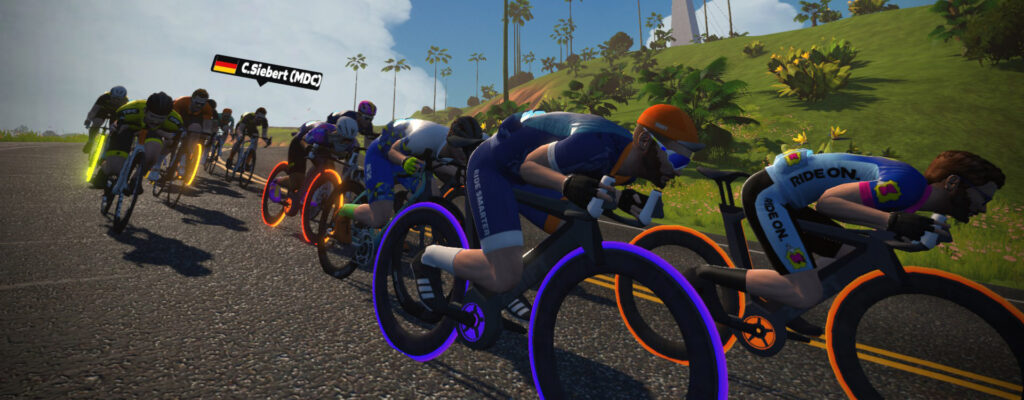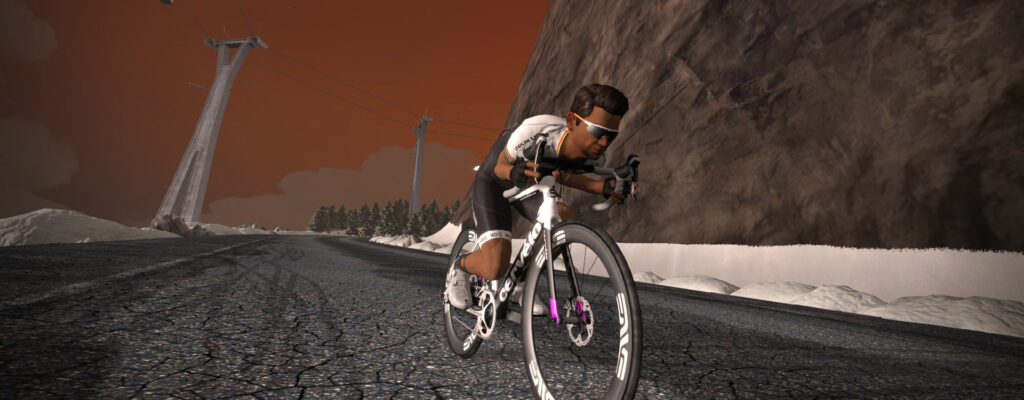Pack Dynamics 4 (PD4) has been in development and testing since October 2022, and yesterday Zwift flipped the switch to take it live across the entire game.
What does this mean for Zwifters? Let’s dig in and find out…
The Need for Updated Pack Dynamics
When Zwift began working on PD4, they had these goals in mind (my comments in italics):
- Reduce pack speed somewhat for large packs
Everyone who races on Zwift knows the large packs move faster than they should, probably because of “churn” on the front (#5) which allows riders to continually slingshot through the draft and into the wind. PD4 should knock the speeds of large packs down just a bit (think 1-2kph). - Make it less punishing if you’re dropped/easier to bridge back up
With packs moving at high speeds, it’s nearly impossible to catch back on if you’re dropped. PD4 makes it a bit easier by reducing the pack’s speed (#1) but it also appears Zwift has pulled some other trickery: making the pack’s draft “shadow” extend further behind the group (around 20 meters) before it begins to drop off quickly. - Make breakaways have a slightly better chance of sticking if the attackers work well together
Again, just reducing the speed of the large packs (#1) helps this happen. Zwift may have also adjusted small group drafting parameters to give them a bit more advantage when working together. - Reduce the number of bunch sprint finishes in races
This logically follows from #3 – if you give breakaways a better chance of sticking, you reduce the number of bunch sprint finishes. - Reduce churn and rider movement in large packs
Reducing the forward/backward motion of riders in large packs makes the game look more realistic and reduces the front-of-the-pack churn that helped drive up pack speeds. The idea here is, you shouldn’t move around in the pack (forward or backward) a lot unless you’re changing your power output in order to do so.
Supertuck Changes

Given the goals above, Zwift chose to modify the beloved supertuck in PD4, making it more realistic and in keeping with how we see it used in IRL races (before the UCI outlawed it, at least).
With PD4, the supertuck only kicks in if you are outside of a pack and not drafting. That means no more crazy-fast mobs of supertuckers chasing back attacks on descents. And in fact, it means breakaways have a much bigger advantage on descents than we’ve seen in the past!
Along with PD4’s new supertuck restrictions, the three previous requirements must also be met for the supertuck to activate:
- You must be traveling at least ~36MPH (~58km/hr)
- The gradient’s decline must be at least -3%
- Your power output must be below 11 watts

Seeing Red?
You may see your power number in the top-left flash red when riding in a group with PD4. The red indicates “autobraking” – the game client slightly slowing your rider as it attempts to predict your intent and keep you from moving forward in the pack when that’s not what you’re looking to do.
In practice, for me at least, the slowing hasn’t been noticeable and has, in fact, kept me where I want to be in the group.
Wrapping It Up
The truth is, going from PD3 to PD4 is a much less noticeable change than when we went from PD2 to PD3. And that’s not a bad thing – it means Zwift is getting closer and closer to the pack physics we all want.
If you don’t race, there’s even more chance you won’t notice the move to PD4. Racers will probably notice the lack of group supertucking quickly, and we can expect the number of breakaways to increase as riders learn they stand a better chance thanks to PD4.
Ultimately, PD4 should lead to more dynamic and realistic racing, so I give it a big thumbs up.
Planned Tests
We plan to do some drafting tests with PD4, to see if it’s changed the numbers. Watch Zwift Insider for news on that front.
Zwift says PD4 shouldn’t change the speeds for solo riders, but we’re running a few tests just to confirm that. If things have changed, you’ll hear from us soon.
Questions or Comments?
Post below!

